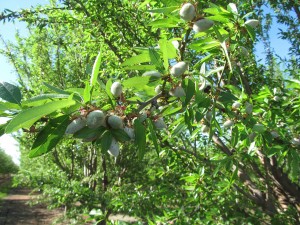
Director, Member Relations
 This report covers conditions and observations made between Friday, February 27 and Sunday, March 15, 2015. The next report is scheduled for Monday, March 30, 2015. However, in the event of any significant occurrences prior to that date, this site will be updated as soon as possible.
This report covers conditions and observations made between Friday, February 27 and Sunday, March 15, 2015. The next report is scheduled for Monday, March 30, 2015. However, in the event of any significant occurrences prior to that date, this site will be updated as soon as possible.
Following a chilly start when cold morning temperatures provided a bit of anxiety, growers in the Sacramento Valley have enjoyed increasing temperatures that have provided strong support for the developing almond crop. Morning minimum temperatures dropped into the lower 30’s during the first days of the month, inspiring growers with water available to run their irrigation systems to prevent damage to the developing nutlets. While readings in the coldest locations were reported as low as 30 degrees, growers’ efforts proved successful and no damage was reported. Minimum readings in the ensuing days reached more comforting levels, rising successively into the upper 40’s and mid 50’s by the end of the period. With a brief pause on March 10th and 11th , when a weak weather system dropped temperatures into the mid 60’s and from a few hundredths to as much as four-tenths of an inch of rain, daily maximum readings also followed an upward trend. Temperatures reported in the upper 50’s and lower 60’s at the end of February rose steadily into the lower 80’s by the conclusion of the period.
 Supported by the earlier start of the bloom and the warming temperatures, growers in the Sacramento Valley are reporting advanced development of the 2015 crop. Nuts are developing rapidly throughout the region with the earliest varieties now out of their jackets and growing rapidly. As they grow, nuts are also differentiating in size. Those that failed to be fertilized or that the trees are unable to support through harvest are being sequestered from the flow of water and nutrients. These will be shed from the trees in the coming weeks, while the balance of the nuts grow and develop strongly. Observers are reporting that the comparatively dry weather over the past few weeks, coupled with grower’s efforts to protect the bloom and the developing nuts have produced very little evidence of disease. However, the rainfall received during the period was accompanied by relatively warm temperatures, conditions quite conducive to fungal growth. As a result, growers are monitoring the weather and their orchards very closely for signs that their disease management efforts should be stepped up.
Supported by the earlier start of the bloom and the warming temperatures, growers in the Sacramento Valley are reporting advanced development of the 2015 crop. Nuts are developing rapidly throughout the region with the earliest varieties now out of their jackets and growing rapidly. As they grow, nuts are also differentiating in size. Those that failed to be fertilized or that the trees are unable to support through harvest are being sequestered from the flow of water and nutrients. These will be shed from the trees in the coming weeks, while the balance of the nuts grow and develop strongly. Observers are reporting that the comparatively dry weather over the past few weeks, coupled with grower’s efforts to protect the bloom and the developing nuts have produced very little evidence of disease. However, the rainfall received during the period was accompanied by relatively warm temperatures, conditions quite conducive to fungal growth. As a result, growers are monitoring the weather and their orchards very closely for signs that their disease management efforts should be stepped up.
Growers have already moved into a growing season mind-set, spurred on by the summer-like conditions. While those planting new orchards are continuing to set trees in the ground, vegetation, insect and nutrient management have come to the forefront in established orchards. Growers are mowing weeds within the orchards, monitoring insect pests and fertilizing the trees to support the developing crop. Additionally, as the leaf cover increases and the temperatures rise, water consumption also increases, forcing growers to begin the irrigation season.
Like growers in the southern San Joaquin Valley, Sacramento Valley growers are also facing water restrictions. Growers serviced by the federal Central Valley Project have been told that they will not receive any water this year, while those covered under the State Water Project have been informed that they will receive 25% of the contracted allocation. Observers are reporting that local districts are still formulating plans for their delivery seasons, with most predicting that they will not be making water available. Growers will obviously be forced to rely heavily on their privately owned wells to carry them through the crop year.